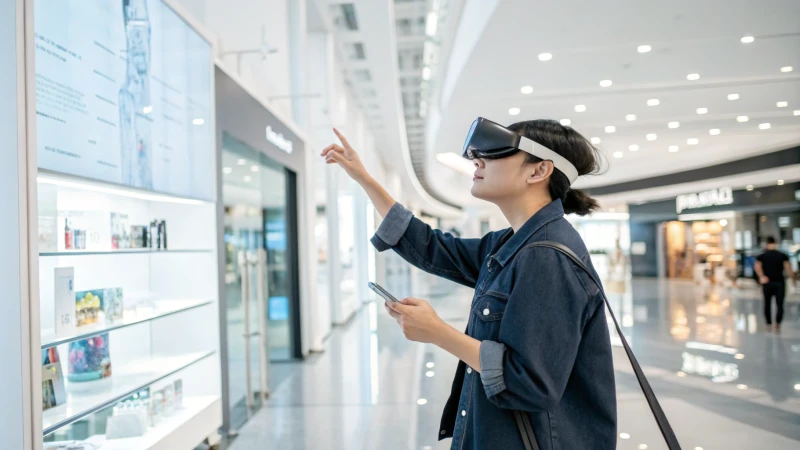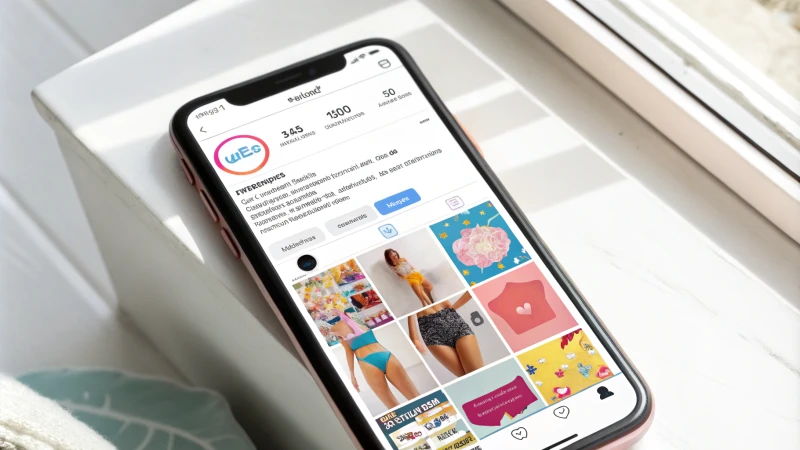
As I have moved through the changing world of fashion, I have learned important lessons. Staying ahead means trying out new ways to advertise. Underwear brands in 2025 need to understand current digital trends. Digital trends really change how we act.
Digital marketing trends for underwear brands in 2025 include personalization through AI. Social commerce integration also plays a key role. Sustainability initiatives gain importance. Augmented reality creates exciting experiences for consumers. These experiences may really interest people.
Every year, diving into these trends feels like unwrapping a gift. Possibilities with personalization through AI bring excitement. Social commerce transforms how we really connect with customers. Sustainability holds a deep, heartfelt commitment to our planet. It's not just a trend. Augmented reality offers consumers a fun and immersive way to experience products before they buy. These trends maybe help us create a unique space in a crowded market. Very unique.
AI personalization will dominate underwear marketing in 2025.True
In 2025, AI-driven personalization is expected to be a key strategy for enhancing customer engagement in the underwear market.
Sustainability initiatives are irrelevant for underwear brands in 2025.False
Contrary to this claim, sustainability initiatives will be crucial for brand reputation and consumer preference in 2025.
How Can Personalization Enhance Customer Experience?
Personalization is changing how businesses work with customers. I invite you to see how unique experiences turn customer happiness into something very special. Personalized interactions bring a unique touch.
Personalization improves customer experience by adjusting interactions according to personal likes. This customization leads to more interest from customers. It builds loyalty. It may even result in higher conversion rates. Brands using personalization well often notice better customer happiness. They also enjoy higher retention.

Understanding Personalization in Customer Experience
I remember the first time I experienced true personalization while shopping online. I bought new shoes and the next time I logged on, the website greeted me with recommendations. These suggestions felt like they were chosen just for me. It was magical! Personalization creates special experiences that match individual likes and actions. Businesses use data to create connections that really speak to their audience.
An online retailer might recommend products based on past purchases or browsing activity. It's like having a personal shopper who knows my style. Every visit to the site feels unique and interesting.
Benefits of Personalization
- Increased Engagement: Personalized messages grab attention like nothing else. I remember seeing an email that used my name and suggested items I liked. It felt like a friend was reaching out and it made me click through. Emails like this often lead to higher open and click-through rates.
- Customer Loyalty: When brands understand what I want, I feel important and noticed. A personalized loyalty program with rewards for my preferences keeps me loyal. There was a brand that did this for me; the more they recognized my tastes, the more I wanted to support them.
- Improved Conversion Rates: Personalization can transform conversion rates. Personalized landing pages may increase conversions by up to 30%. Tailored suggestions on e-commerce platforms have led me to make impulse buys, especially when they reminded me of previous favorite items.
Key Strategies for Implementing Personalization
- Data Collection: Collect data on customer behavior through different channels like website interactions or social media. This information is very important for effective personalization strategies.
- Segmentation: Divide your audience into segments based on shared traits. A fashion brand might group customers by age or style preferences. This reminds me of how my favorite clothing store always gets their promotions right!
- Dynamic Content: Use technology to provide dynamic content that changes based on user behavior. Personalized email campaigns or adaptable website banners can keep each interaction fresh and relevant.
Tools for Personalization
Businesses have tools at their disposal to implement strategies effectively:
- CRM Systems: Customer Relationship Management systems are crucial for tracking customer interactions and preferences.
- Email Marketing Platforms: Tools like Mailchimp help create segmented email campaigns that send specific messages to customer groups.
- Analytics Software: Google Analytics gives insights into user behavior, which is essential for refining personalization approaches.
When done correctly, personalization isn't just about selling a product; it's about building relationships. Focusing on individual needs and preferences nurtures deeper connections with customers, paving the way for lasting satisfaction and loyalty. So next time you think about strategies, remember how powerful it is to make your customers feel seen and valued—it’s truly a game-changer.
Personalization increases customer engagement significantly.True
Tailored messages capture attention better than generic ones, boosting engagement rates.
Dynamic content is unnecessary for effective personalization.False
Dynamic content adapts to user behavior, enhancing the personalization experience and effectiveness.
How Is Sustainability Shaping Modern Marketing?
In a world where interest in the environment is growing, sustainability becomes a vital part of our identity as shoppers. But how do companies adjust to this major change?
Sustainability has a crucial role in today's marketing. Brands connect with consumers who care about the environment. This approach builds loyalty among customers. Many people trust brands that use ethical practices. Sales often increase when companies choose sustainable methods.

The Move Towards Sustainability in Marketing
Sustainability really matters to me; it is a promise that touches the hearts of many people. I remember the first time I chose an eco-friendly product. I felt like I was standing up for something important, not just for myself but for the world. Today, many shoppers expect companies to take care of their environmental impact.
The change towards sustainability in marketing is very important. It is no longer a small concern but a common expectation from consumers. I have seen brands shift their stories to focus on social responsibility and caring for the environment.
For example, eco-friendly packaging1 has become a hallmark of brands looking to showcase their commitment to sustainability. Such practices not only attract eco-conscious consumers but also enhance brand loyalty.
Consumer Behavior and Brand Perception
Studies show many people prefer buying from sustainable brands. Surprisingly, up to 66% of global consumers are willing to pay more for brands that put sustainability first. This knowledge changed how I shop. Now I look for brands that share my values.
| Aspect | Impact on Consumers |
|---|---|
| Brand Loyalty | Increased retention rates |
| Willingness to Pay | Higher price tolerance |
| Trust | Enhanced credibility |
When brands talk clearly about their sustainability efforts, they win the hearts of eco-friendly buyers. They create a community feeling too. I have seen fashion campaigns that mix storytelling with marketing, leaving a strong emotional mark.
Adding Sustainability into Marketing Plans
Adding sustainability into marketing involves more than just ticking boxes. It needs to be part of the brand’s core. Here are some key ideas I think could help:
- Clear Communication: Brands should openly talk about their sustainability goals and share updates to keep consumers informed.
- Genuine Partnerships: Working with environmental groups can build a brand's trustworthiness.
- Clever Product Design: Using sustainable materials helps brands stand out and attract thoughtful consumers.
- Interesting Content: Using social media to share educational topics about sustainability builds trust and educates.
Imagine a brand starting a new line of organic cotton underwear with a campaign on organic farming practices. It is not just about the product; it is about teaching consumers and involving them in something bigger.
Successful Sustainable Marketing Campaigns
I feel inspired by brands that have embraced sustainability:
- Patagonia: Their “Don't Buy This Jacket” campaign encourages careful buying and adds to their sustainability promise.
- Toms Shoes: Their one-for-one model connects emotionally with buyers wanting to make a positive change.
These examples show how sustainable marketing can strengthen brands and foster customer loyalty while facing urgent environmental issues. As I choose what to buy, these brands remind me every decision matters. They inspire me to support sustainability in my daily life.
66% of consumers prefer sustainable brands over others.True
Research shows that a significant portion of global consumers are inclined to choose brands perceived as sustainable, highlighting consumer preference.
Eco-friendly packaging has no impact on brand loyalty.False
Contrary to this claim, eco-friendly packaging is shown to enhance brand loyalty among environmentally conscious consumers.
How Is Augmented Reality Transforming Product Engagement?
Augmented Reality (AR) is more than just a trendy term. AR changes how we interact with products individually. Shopping becomes more exciting with AR. It really transforms the entire experience.
Augmented Reality (AR) changes how people interact with products. Consumers probably use AR to see products in real-time with virtual experiences. This builds customer confidence and lowers purchase risks. Shopping becomes more personal and interesting.

The Rise of Augmented Reality in Marketing
Marketing has entered an exciting new era with Augmented Reality (AR). Picture stepping into a sci-fi film where digital and physical worlds merge smoothly. The first time I used an AR app while shopping for furniture felt magical. It was like creating my dream living room right in my space. This immersive experience captures consumers' attention and changes our shopping journey.
For instance, AR allows customers to visualize how products will look or fit before making a purchase. Virtual fitting rooms2 are becoming commonplace, allowing users to try on clothing or accessories virtually. This innovation not only enhances customer experience but also fosters greater confidence in purchasing decisions.
Enhancing Customer Interaction
AR changes the usual shopping experience completely. When I engage with brands using AR, I become an active participant in my shopping adventure. This change draws customers like me to unique experiences that AR provides.
Key Benefits of AR Engagement:
| Benefit | Description |
|---|---|
| Increased Engagement | Users spend more time interacting with AR features. |
| Enhanced Visualization | Customers can see products in real-world contexts. |
| Reduced Return Rates | Greater confidence leads to fewer product returns. |
A great example is IKEA Place. This amazing app helps users see how furniture looks in their homes before buying. I remember the thrill of placing a virtual couch in my living room. This redefines how we connect with brands!
Case Studies in AR Product Engagement
Many brands now explore AR and enjoy the benefits. Some have truly wowed me:
- L'Oreal: Their AR app lets users try on makeup virtually. I've explored it countless times and it’s clear that it leads to increased user interaction and online sales!
- Nike: With their AR feature, I visualize sneakers on my feet before buying them. This feature improves the entire shopping experience.
- Sephora: Similar to L'Oreal, Sephora's app lets me test various makeup looks before purchasing, making shopping feel more enjoyable than obligatory.
The Future of AR in Consumer Experience
Technology evolves rapidly and AR's future in product interaction looks very bright. Think about innovations like AR-enhanced packaging3. Imagine scanning a product label and discovering interactive content! This could revolutionize how brands communicate product value.
Brands adopting these innovations improve our consumer experiences and remain competitive in a changing market. As 2025 approaches, businesses should grasp and use AR technology to strengthen customer connection and loyalty.
AR technology enhances customer confidence in purchases.True
Augmented Reality allows users to visualize products in real life, increasing their confidence and reducing the likelihood of returns.
Virtual fitting rooms are ineffective for consumer engagement.False
Contrary to this claim, virtual fitting rooms significantly boost consumer interaction and satisfaction by allowing realistic product trials.
What Are the Benefits of Social Commerce for Underwear Brands?
Have you ever thought about how social selling could shift the game for underwear companies? It’s amazing how mixing social media with selling methods really increases visibility. This creates strong bonds with buyers. Let’s look at these big benefits together!
Social commerce benefits underwear brands by increasing visibility. It allows direct customer interaction. This approach makes the buying process easier. It enables targeted advertising. It offers valuable insights through analytics. It also helps build a community. These advantages really empower brands. Companies connect well with consumers. Brands ultimately boost sales.

Strong Brand Visibility
Social commerce shows underwear brands to people on popular social media. By utilizing visual content4 such as stunning images and videos, brands can create eye-catching posts that draw in potential customers. This form of engagement leads to increased brand awareness and a more prominent online presence.
- Example: A men's underwear brand used Instagram Stories to show followers behind-the-scenes product launches, resulting in a 30% increase in engagement over typical posts.
Direct Customer Connection
One of the primary benefits of social commerce is the ability to engage directly with customers. I often talk to brands on social media, asking questions or leaving comments. Fast replies foster a sense of community and build loyalty among customers.
- Insight: Brands that talk directly with customers on social media see more customer loyalty, as personalized interaction makes customers feel valued.
Easy Shopping Experience
Imagine buying new underwear directly from an app like Instagram! Social commerce integrates shopping features within social media platforms, making it easy for users to buy products without leaving the app. This reduces cart abandonment rates and increases sales for underwear brands.
| Platform | Shopping Feature | Benefit |
|---|---|---|
| Shoppable Posts | Direct links to products from posts | |
| Shops | Dedicated storefronts within Facebook | |
| TikTok | Shopping Tabs | Product links integrated in videos |
Targeted Ads
Social media provides lots of data for brands to customize ads based on user behavior, interests, and location. Some underwear brands target young fashion enthusiasts effectively.
- Example: A women’s underwear brand focused ads on fashion-forward young adults, achieving better results and spending less money.
Useful Analytics
Brands get important data about customer likes and actions through social commerce tools. Metrics such as engagement rates, click-through rates, and conversion rates help improve strategies over time.
- Recommendation: Regular analysis of these metrics guides brands in refining their marketing strategies to increase profit.
Community Building
Social commerce doesn’t just sell items; it forms communities around brands. User-generated content lets customers share experiences with products, attracting potential buyers through genuine stories.
- Strategy: Contests or challenges where customers show how they wear their underwear can significantly boost engagement and create organic buzz.
Social commerce boosts brand visibility for underwear brands.True
By showcasing products on social media, underwear brands enhance visibility and awareness among their target audience, increasing engagement significantly.
Direct interaction on social media lowers customer loyalty.False
Engaging with customers directly on social media fosters community and loyalty, leading to higher retention rates for underwear brands.
Conclusion
Underwear brands in 2025 should focus on AI personalization, social commerce, sustainability, and augmented reality to improve customer engagement and differentiate themselves in the market.
Explore effective sustainable marketing strategies and see how companies are successfully integrating eco-friendliness into their brand messaging. ↩
Explore how AR is enhancing consumer interaction with products and shaping marketing strategies. ↩
Learn about innovative AR applications that improve customer experience and product visualization. ↩
Explore how social commerce enhances brand visibility and customer engagement, providing practical insights for your marketing strategies. ↩






